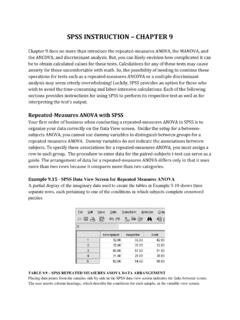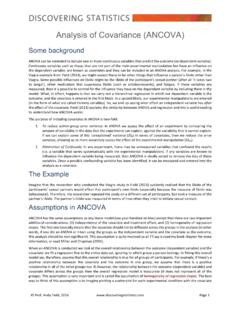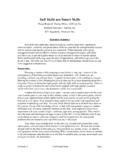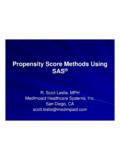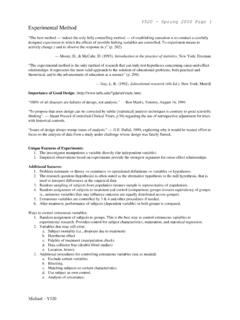Transcription of Essentials in Stability Analysis and Expiry Determination
1 Published in BioPharma International. Essentials in Stability Analysis and Expiry Determination Thomas A. Little 6/12/2013 President Thomas A. Little Consulting 12401 N Wildflower Lane Highland, UT 84003 1-925-285-1847 The Need for Stability Analysis Stability assessment is a critical aspect of all drug development activities. Stability of the drug product and drug substance may impact both drug efficacy as well as drug safety and is generally regarded as a critical quality attribute of every drug and vaccine. Both small molecule and large molecule drug substance and drug products are impacted by Stability concerns. Primary consideration is given to those factors that impact drug potency and the formation of impurities over time. Specifically ICH Q1A(R2) General Principles states: The purpose of Stability testing is to provide evidence on how the quality of a drug substance or drug product varies with time under the influence of a variety of environmental factors such as temperature, humidity, and light, and to establish a re-test period for the drug substance or a shelf life for the drug product and recommended storage conditions.
2 The primary factors for any Stability study are time, batch, and environmental factors. The primary environmental conditions are moisture/humidity and temperature. A risk assessment (Q9) should be completed to evaluate any additional environmental factors the drug may be sensitive to. In addition there are factors associated with the drug product and drug substance that may impact Stability such as pH, excipients, API concentration, hold times, etc. that should be included in the overall Stability evaluation and during drug development. Phase Appropriate Stability Determination Stability testing should begin at the beginning of early drug development (Q8) with early formulation and process/method development. Generally, accelerated Stability testing followed by confirmatory long term Stability testing is considered a best practice (Figure 1). Care needs to be exercised that accelerated Stability testing is representative of long term testing and does not cause degradation pathways that are not present in the nominal storage environment.
3 Once long term Stability data is available calibration and correction of the accelerated Stability estimates are possible. FormulationProcess DevMethod DevStability TestingPre ClinicalPhase IPhase IIPhase IIIL aunch +Drug in Liquid FormEarly Formulation StudiesDrug in LyophilizedFormFinal Formulation Process andMethod Development Process ValidationAcceleratedConfirmatoryAcceler atedConfirmatoryAcceleratedConfirmatoryA cceleratedConfirmatory Figure 1. Phase Appropriate Stability Testing At each phase of development, formulation modifications, process changes and refinement in analytical methods are made causing the Stability evaluation to be challenged, updated and modified. Care needs to be exercised that representative material batches are selected for testing and the associated Stability data, Analysis and reports are submitted to the regulatory agencies. Two Methods for Stability Determination If the parameters are Stability indicating (change over time), regression Analysis is a primary method for Determination of Stability , as the factor is time and the response(s) are the release drug attributes and any additional attributes for drug characterization.
4 The two methods are based on a rate of degradation and the confidence interval associated with the rate of degradation. Rate of degradation is best for early development when sample sizes are small, confidence interval based Expiry is best for long term studies when the sample sizes and time intervals have more data. Simple linear regression provides a rate of degradation (slope), starting value at time 0 (intercept), a confidence interval of the mean estimate at each time point and residual error around the regression line (Figure 2). Nonlinear and other types of special linear models (sqrt,1/x, log, exponential, polynomials) are generally avoided unless specifically indicated from the data, historical experience and or a careful Analysis of the residuals. The extrapolation of the nonlinear or special fits may produce nonsensical and or irreproducible estimates of shelf life when extrapolated so they must be used carefully.
5 Figure 2. CI based and Slope Based Expiry ICH Q1E, regarding extrapolation states the following: An extrapolation of Stability data assumes that the same change pattern will continue to apply beyond the period covered by long-term data. The correctness of the assumed change pattern is critical when extrapolation is considered. When estimating a regression line or curve to fit the long-term data, the data themselves provide a check on the correctness of the assumed change pattern, and statistical methods can be applied to test the goodness of fit of the data to the assumed line or curve. No such internal check is possible beyond the period covered by long term data. Thus, a retest period or shelf life granted on the basis of extrapolation should always be verified by additional long-term Stability data as soon as these data become available. The 95% confidence interval is used in determining Expiry and takes into account the sample size, variation in the batch data and number of time points.
6 In early development when the sample size is small it is best to focus on degradation rate, in Phase III Stability when the number of batches are higher and the sample sizes are greater it is best of focus on the confidence interval and the predicted Expiry at 95% CI. Statistical Models for Stability Analysis The general multivariate Analysis for Stability and Expiry is an Analysis of Covariance (ANCOVA) or mixed model. Alpha for all model terms are set at except for all batch related terms (main effects and interactions) and they are set per guidance at alpha= Setting the batch related terms to will cause the Expiry to shorten and favor the consumer/patient with shortened shelf life. Stability Analysis is typically analyzed for each storage condition and rates of degradation and expiries are determined. The simplest model where every term is significant per the alpha criteria above is selected for computing the Expiry .
7 The model type is ANCOVA the statistical test is an ANOVA (Figure 3) and should be included in submission reports to make sure the model used is appropriate for the Analysis and tests for lot pooling have been correctly conducted. The ANOVA summarizes the significant model terms and indicates the correct model has been selected for the data being analyzed. ICH QE discusses the Analysis of Stability data and the general guidance on Analysis , pooling of lot data and submission. There are four possible models that are used in Stability Analysis . They are as follows: Model Model Terms Full Model Time, Batch, Time*Batch Common Slopes, Separate Intercepts Time, Batch Common Intercepts, Separate Slopes Time, Time*Batch Pooled Time Figure 3. ANCOVA Full Model Individual Slopes and Intercepts DOE and Stability Design of Experiments is often used to include additional factors in the Analysis and evaluation of Stability .
8 This is particularly true of formulation studies, influence of excipients, pH etc. ICH Q1D provides guidance on designing and Analysis of Stability studies using DOE. In general when designing Stability DOEs time is not included in the matrix generation, it is typically included as part of the response as there are multiple measurements per time point for each condition in the matrix. The matrix is stacked, time is crossed with each model term and then the appropriate Analysis is performed with time as a factor and all other model terms. Impact of Stability on Tolerance Design Stability is a key consideration when setting product specification acceptance limits. Specification limits should first and foremost take into account the impact of variation of the drug product on efficacy and safety and then secondarily it should take into account three sources of variation: 1) product/process variation, 2) assay or method variation and 3) Stability variation (Figure 5).
9 Failure to understand and or account for Stability when setting limits will assure a very problematic Stability program and may prevent the product from being commercially viable or create excessive unnecessary product and supply chain costs in many cases. Time Figure 4. Tolerances and Stability Specifically ICH Q6B Background states: Specifications are one part of a total control strategy designed to ensure product quality and consistency. Other parts of this strategy include thorough product characterization during development, upon which many of the specifications are based, adherence to Good Manufacturing Practices, a validated manufacturing process, raw materials testing, in-process testing, Stability testing, etc. Stability and rates of degradation should be compared to the USL and LSL limits during early development and throughout the product lifecycle. Stability effect size (Figure 5) should be calculated as follows: Two Sided Specification Limits (Slope/(USL-LSL))*100= percent of change in tolerance per time period One Sided Specification Limits USL only: (Slope/(USL-batch average))*100=percent of design margin LSL only: (Slope/(batch average-LSL))*100=percent of design margin No Specification Limits No limits: (Slope/batch average)*100=percent of average per time period Figure 5.
10 Typical Stability Report Accelerated Stability Analysis The full discussion of accelerated Stability studies may be beyond the scope of this paper; however, the basics will be provided. The accelerated Stability study must add value and be predictive of long term Stability studies to be of practical benefit to the development process. The basic steps in an accelerated Stability study are as follows: Figure 6. Accelerated Stability Study 1. Determine the purpose of the accelerated Stability study. 2. Selection of acceleration factors and ranges to be included in the accelerated Stability study. 3. Determination of the number of time periods in hours, days or weeks 4. Building the accelerated period model and rates of degradation at each temperature/storage condition (Figure 6). 5. Generalization of the model for any temperature or storage condition (Figure 7). 6. Prediction of Stability at nominal storage conditions ( Expiry , Rate of Degradation, and Acceleration Factor).


